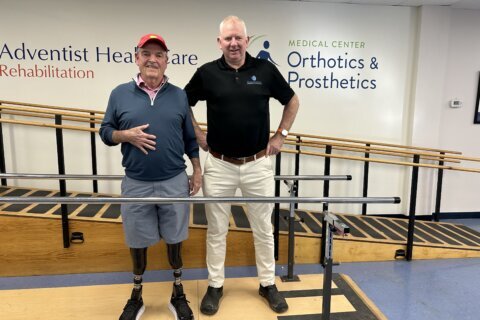WASHINGTON D.C. (AP) — Shannon McAdoo, a former bookkeeper in Erie, Pa., spends her evenings hunting for ancestors on genealogy websites.
“You can find the most amazing things about your history,” she said. “I go down all these rabbit holes.”
This year, in an effort to widen her search, McAdoo swabbed her cheek with a long Q-tip and sent her DNA to a genealogy website that specializes in making genetic family matches.
McAdoo, 53, had no idea she would apparently help solve a family mystery: what happened to her cousin, Margaret Fetterolf, a habitual runaway who went missing from her Alexandria, Va., home in 1975 at age 16.
For decades, Fetterolf’s family held out hope that she would one day show up for Thanksgiving dinner.
All the while, cold case detectives struggled to identify a body found in 1976, 50 miles away near a Baltimore County cemetery. The victim was known only as the Woodlawn Jane Doe, after the community outside Baltimore where she was discovered — strangled, sexually assaulted and wrapped in a white sheet, her hands bound.
This summer, detectives identified the Woodlawn Jane Doe as Fetterolf using a controversial new law enforcement technique: linking the DNA of unidentified bodies and potential suspects in serious crimes to relatives who upload their DNA to genealogy sites that allow police to access their genetic information. The technique, as one scientific paper metaphorically put it, reduces the size of the investigative haystack, allowing investigators to “identify the needle.”
To law enforcement agencies, investigative genetic genealogy has led to a windfall of closures of unsolved cases, including the identification of the Golden State Killer in 2018. But privacy and legal ethics experts worry the technique will turn family members into unwitting “genetic informants.”
“Identifying and prosecuting the perpetrators of serious violent crimes, like the Golden State Killer, is a victory for public safety,” Natalie Ram, a University of Maryland law school professor, wrote last year in an American Bar Association publication. “Nevertheless,” she added, “the loss of privacy may not be a justifiable cost to civil society, much less justified in every instance of criminal investigation to which it could be applied.”
Though a Pew study last year found that 48 percent of Americans support the practice of DNA testing companies sharing information with police, some states are moving to curtail usage of genetic genealogy for solving crimes.
This week, a law in Maryland went into effect limiting law enforcement’s use of genealogy websites to serious violent crimes. Under the law, the sites can be used only under the supervision of a judge and after all other investigatory methods have been exhausted.
Fetterolf’s case certainly would have qualified.
Edward Fetterolf, Margaret Fetterolf’s younger brother, said she began running away when she was 12. She was rebellious and constantly in trouble. When she got placed in foster homes, she ran away from those, too.
“Then she would beg to come back home and my parents would let her come back home and then she’d run away again,” Edward Fetterolf said in an interview. “So it was just a revolving door.”
In the late summer of 1975, she ran away again. But this time was different. A week went by, and she hadn’t returned. Then a month. The family hoped she would one day turn up on someone’s birthday or at a family holiday. Those hopes, spread out over months and then years, faded as time passed. They suspected the worst.
Meanwhile, unbeknown to the Fetterolfs, there was the mystery of the Woodlawn Jane Doe. Though the case had been featured on crime shows and public campaigns to help identify the body, nobody in the immediate Fetterolf family, still residing in Alexandria, had heard of the case.
Baltimore County detectives, working in conjunction with the National Center for Missing and Exploited Children, had never given up trying to identify the body. Detectives had even conducted a sophisticated pollen analysis of Fetterolf’s clothing that took them to Boston looking for clues.
“Unfortunately, we weren’t able to identify any substantial leads,” Baltimore County police Cpl. Dona L. Carter said.
Then detectives turned to investigative genetic genealogy. Partnering with Bode Technology, a Lorton, Va., company that uses DNA to identify crime suspects and unidentified victims, detectives sent scientists items containing the Woodlawn Jane Doe’s DNA that had been stored for decades.
That’s where the needle-haystack metaphor enters the story.
Of the dozens of DNA genealogy sites operating in the United States, only two — FamilyTree DNA and GEDmatch — permit law enforcement to use their databases. Both companies require participants to authorize potential police use during the sign-up process.
FamilyTree DNA and GEDmatch also allow users to transfer their DNA samples from other services, such as Ancestry.com and 23andMe. That’s what McAdoo did after having her DNA initially analyzed by 23andMe, though she said she was told by authorities not to disclose the name of the company she transferred her data to.
Bode Technology officials would not detail exactly how many or which family matches were used in the case. However, they did detail the process: Once they identified site users whose DNA appeared to be related to the victim’s, a genealogist employed at the company used public records to narrow down relationships. In Fetterolf’s case, the company was able to build out the family tree down to her parents and their three children.
The company and investigators found that there was no public information about Margaret Fetterolf beyond high school and became reasonably certain that she was the Woodlawn Jane Doe. Detectives then went to interview her relatives and took DNA samples, confirming the body was hers.
Edward Fetterolf said he was told by authorities that three cousins or relatives had apparently uploaded their DNA to the companies used by Bode. He hadn’t spoken to McAdoo for several years until this summer, when he called to tell her the news and say thank you.
“It was totally out of the blue,” McAdoo said. “I really couldn’t believe it.”
Carter, the Baltimore County police detective, said media reports last month about the identification of the Woodlawn Jane Doe had generated several calls from people who knew Fetterolf back in the 1970s. They are hoping anyone who remembers anything about her during that time will contact them.
“No detail is too small,” Carter said.
Including whatever specks of DNA were left to finally connect the Woodlawn Jane Doe to her family.
“I know people are concerned about the whole DNA genetic informant thing,” McAdoo said. “I get it. But I just think it’s important to encourage people to … upload their DNA because we don’t know how many other people are out there waiting for an answer.”
Copyright © 2024 The Associated Press. All rights reserved. This material may not be published, broadcast, written or redistributed.







